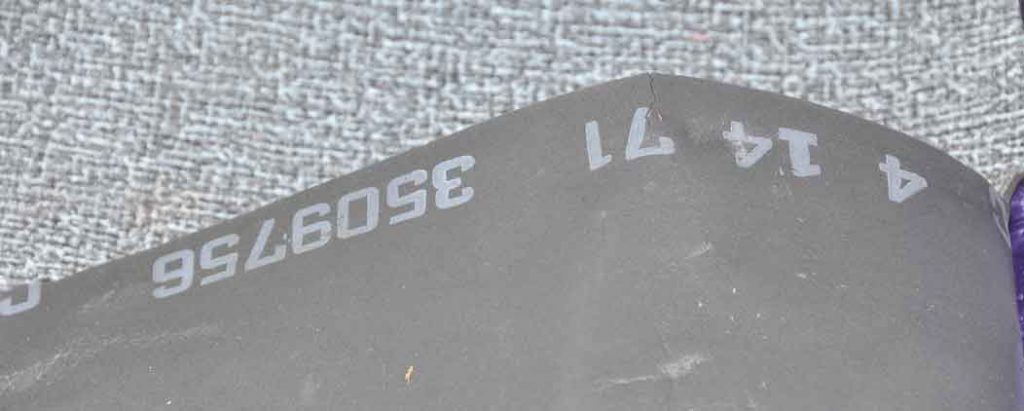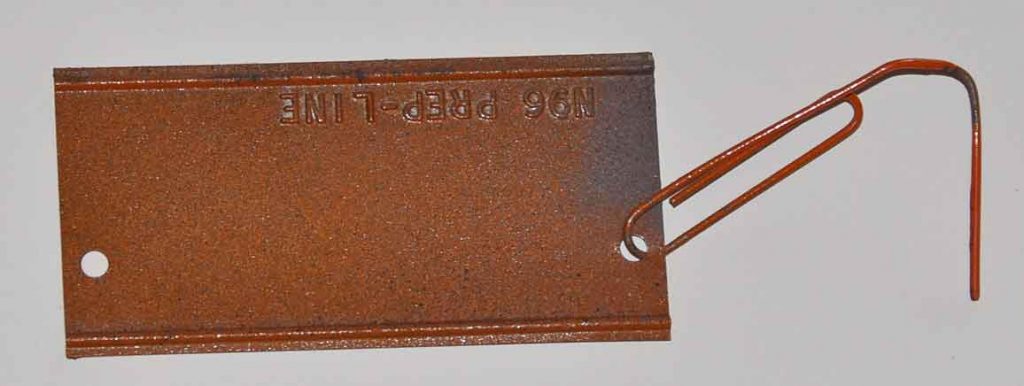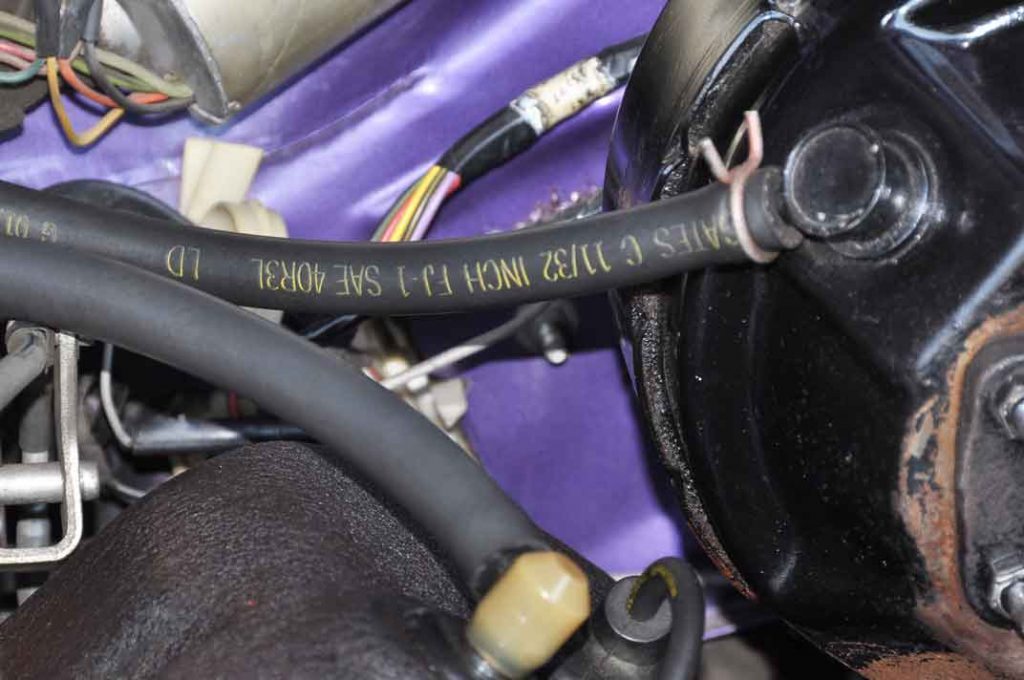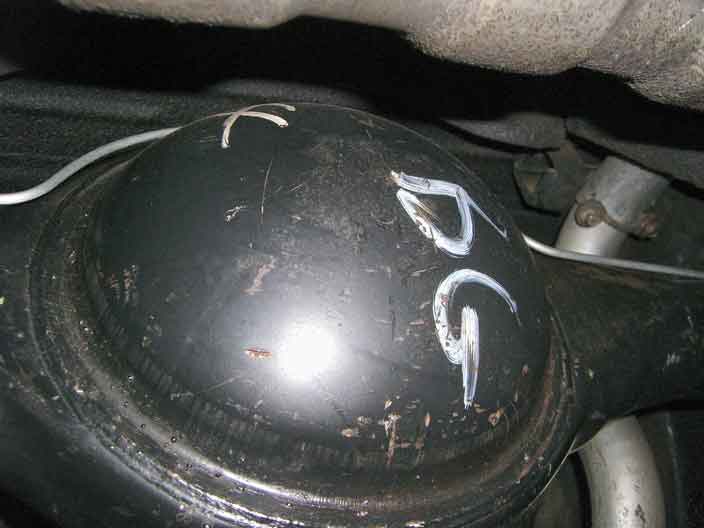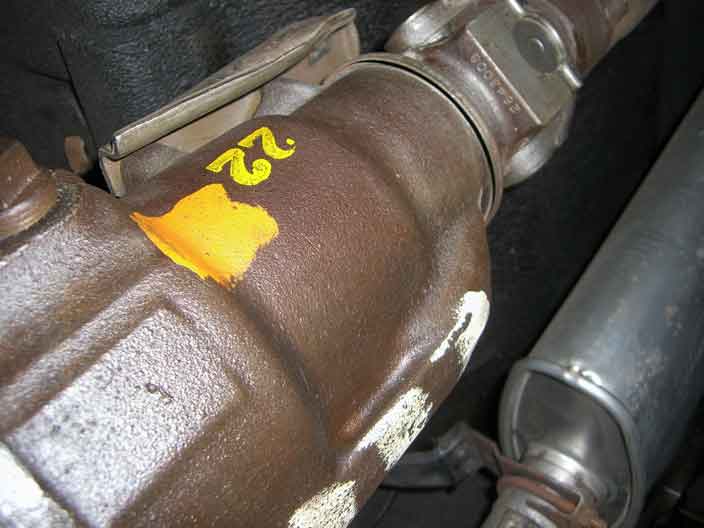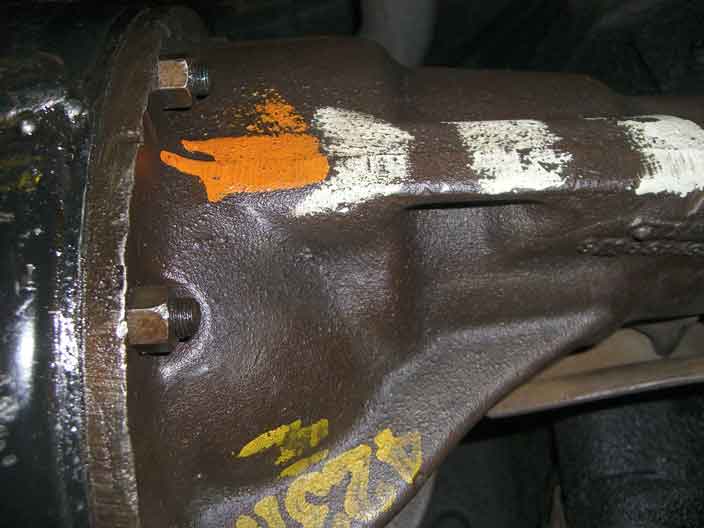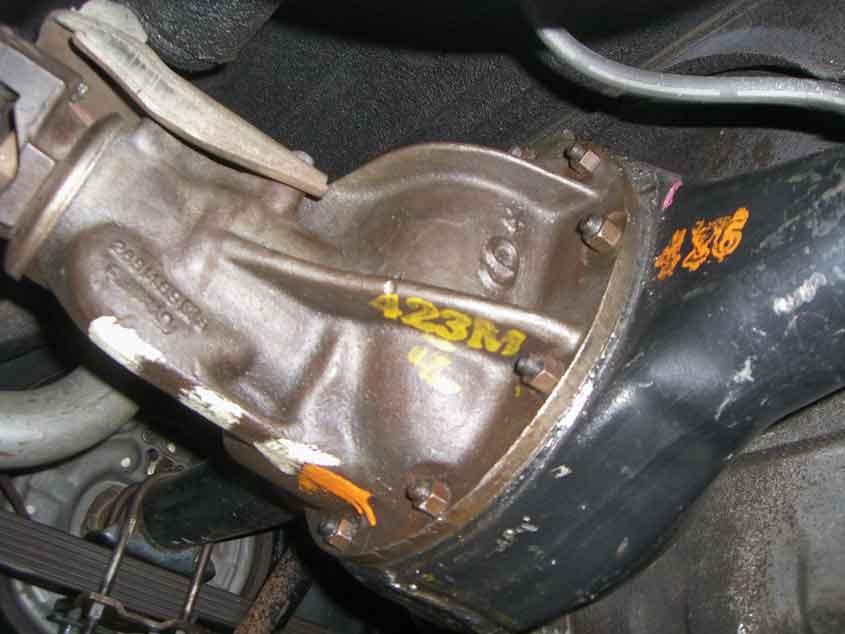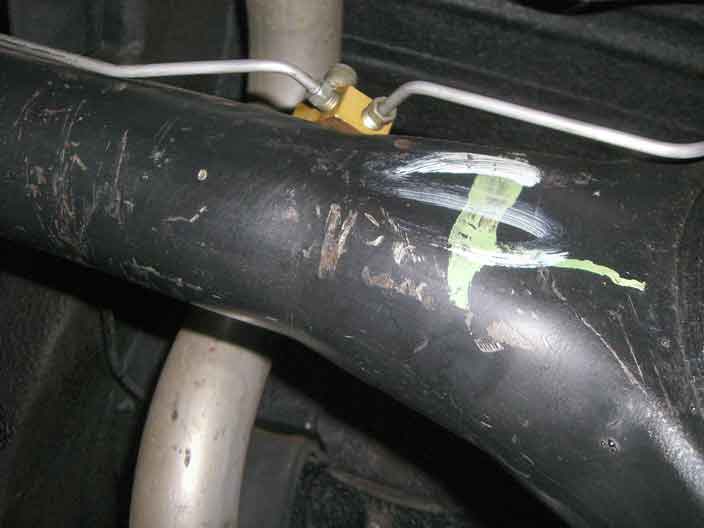Purple Reign
1971 Hemi Charger: Details of the king of unrestored original Mopars on the planet.
Story and photos by Cliff Gromer

James Thomas, a man in his mid-50s at the time, bought this Hemi Charger R/T new in 1971 from Van Campen Dodge, in Williamsport , PA.
Jim knew that this was goĀing to be the last year for the Hemi, and he ordered the car loaded with two fender tags and two window stickĀers worth of options. The car would be one of 33 Hemi Charger R/T automatics (30 4-speeds were made).
Jim Thomas, a mechanic in Williamsport, PA used to amuse himself watching the service guys at Van Campen Dodge–the dealership across the street–drive the new Hemicars that came off the transporter into the dealership. It seemed to be a contest of who could leave the most rubber, and get the cars the most sideways. Jim would just shake his head and go back to changing oil or repacking wheel bearings. Jim would buy himself a new car every 10 years or so, whether he needed one or not.

Steve Juliano says that heās never washed or hand-waxed the Charger. Big deal. Weāve never washed or waxed our ā98 Neon, and if we do, weāll first scrape off all the original road grime and bird poop and store it in a plastic bag that we can use for display at shows or a magazine article (only if we get the cover).
So, when Jim walked across the street and signed on the dotted line for a new 1971 Hemi Charger, he made sure the dealer understood that the car would roll off the hauler and into his shopānot the dealerās service department. Hey, if anyone was going to violate the virgin rubber on the rear wheels, it sure as heck wasnāt gonna be those crazed burnout junkies in the service department.

Rear spoiler was a $37.30 option. Front and rear colored bumpers added another $21.40. Such a deal.
By the looks of things, Jim was more of a neat freak than a rubber rapist. A real neat freak. Jim had rolled up over 10,000 dent-, ding-, dirt-, scratch- and lint-free miles when he bought the car to sell at the Carlisle Mopar meet back in 1984. One of the tire kickers (Jim bought along an old tire that he set up for potential buyers to kick so they wouldnāt scuff up the original Goodyears) was noted restoration expert, Frank Badalson. Frank knew what he was looking atāan unmolested original in pristine shape. But the asking priceā15 grand–was $1,500 more than Frank wanted to spend. They haggled and haggled, but Jim wouldnāt budge. Frank kicked the tire and walked away (in retrospect, he probably kicked himself).

ā71 wiper motors, unlike ā70, donāt have that red Glyptol slime on them around the wiring in the circular area. Also note the correct dull finish of the wiper motor. Repops and restorations are always too shiny.Ā When engine was painted, they were shooting from the passenger side over pretty heavy, but not as heavy from driver to passenger side. The driverās side of the throttle return spring bracket shows very little paint. Same deal at the rear of the engine where the kickdown bracket is. The steering box and column joint are painted, and the steering shaft painted a bit past the shaft joint and then the paint fades off. Steve says he sees this on all survivor cars.Ā Hints of orange paint on valve covers indicate they were in place when the engine was painted.
A mailman, spotted the Charger as a special delivery (get it? This is why weāre worth the six bucks) and bought it. The car basically sat in his climate-controlled garage and saw virtually no mileage. But the guy did do one thing to this absolutely-untouched-factory-original-in-every-respect Hemicar: he spray-painted around the thermostat housing area because the original paint was peeling off, and it didnāt look nice. Way to go, mailman!

Frank Badalson told us the ā8″ on the front of the left valve cover is a factory designation for ā71 Hemi auto engine assembly.Ā On a ā71 build sheet for an automatic Hemi, in the “engine” box the last 3 digits are ā408.ā
In 1992, the Charger was put up for sale once again. Rich Dobbins, accompanied by his friend, Steve Juliano, showed up at the mailmanās door. Rich is a Mopar survivor freak, and he instantly fell in love with the Charger. He looked at Steve who told him that if Rich didnāt buy the Charger, he would. Rich made the deal and brought the car home to his own climate controlled garage. He did take it out a few times and he did put his foot into it (how could he resist?) But basically, the Dodge just sat. An easy life.

Some of the plug wires are date-coded the third quarter of 1969, while others show the fourth quarter. Carburetors: The 1971 parts book shows a 4871 front carb and a 4669 (4-speed trans) or 4670 (auto trans) rear carb. But these carbuĀretors were never installed on the asĀsembly line, and would not be correct for a Reference Restoration. In fact, the factory installed 1970 carbs on the 1971 Hemisāa 4742 front, and 4745 (4-speed) or 4746 (auto) rear. Carter re-stamped an M over the 1970’s L part number.
In 1997, Rich was looking to buy a home, and the Charger would make a nice down payment. He called Steve and said the car was for sale, but he had promised someone else the right of first refusal. Steve told him it was simple. “I respect the other guyās first refusal rights, but if he hesitates for an instant, forget it. I am ready to pull the trigger.ā Rich called the guy. āGee, nowās not a really good time, let me get back to you, Iām still very interestedā¦yaddaā¦yaddaā¦ā Click!

The Air Grabber assembly shows all the correct fasteners and finishes. Note the original plastic wire looms and the original paint runs that still are original in the hood. The plating on the hardware is as fresh as the day it came out of the tanks.
Steve picked up the Charger the next day and drove it home (about 30 miles). Going over the car, Steve couldnāt believe its condition. He says the original owner was even crazier than he is (and Steve is pretty anal about the cars and memorabilia in his amazing collection). Jim had never put anything in the trunk. It doesnāt look like Jim even opened the trunk. It appears that no one ever sat in the rear seat. The wipers have never been turned on, and original wiper blades have never even traveled over the stainless steel trim at the bottom of the glass. The inside of the wheelwells were even more pristine than those on Steveās restored cars. Jim mustāve spent most of his time just wiping down the Dodge with a diaper.
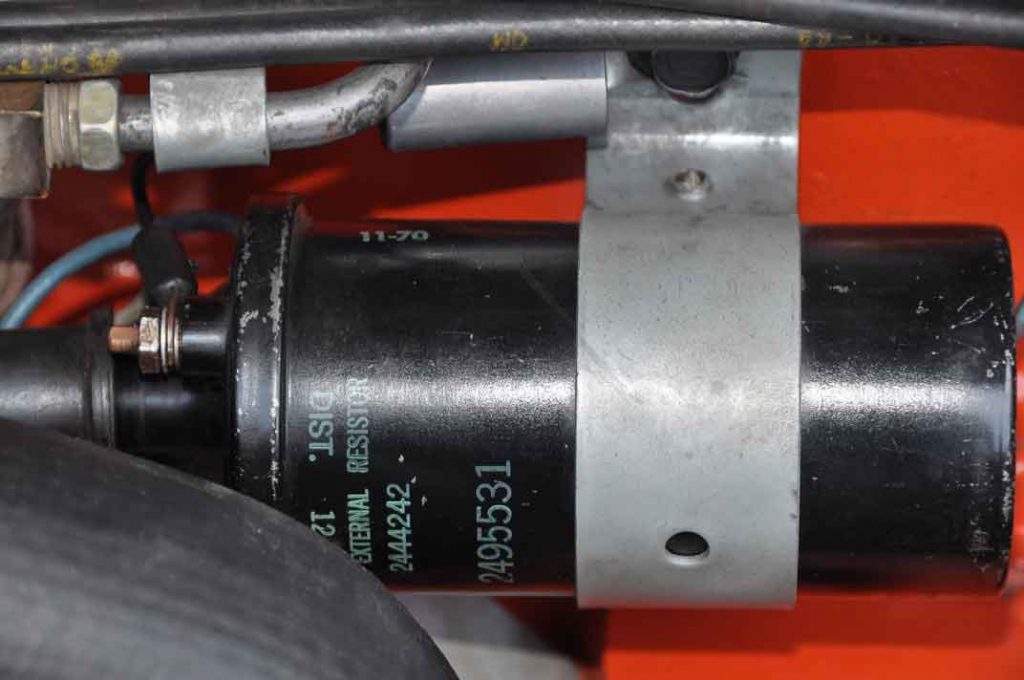
Beautiful example of an original coil with a date code (top of photo) only a Chevy guy couldnāt break.
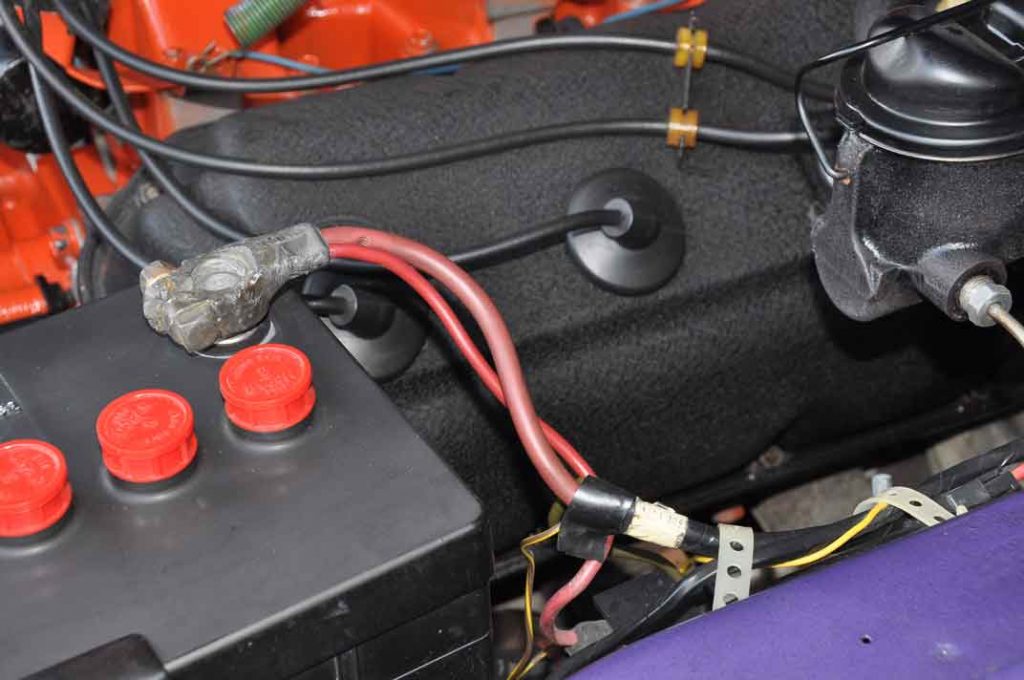
One (or more of the earlier owners wasnāt afraid to jam jumper cables on this factory-original positive cable. The white area above the cable strap is the part number tag. Note the color difference between the heavy cable and thin wire. On repops both are the same color.
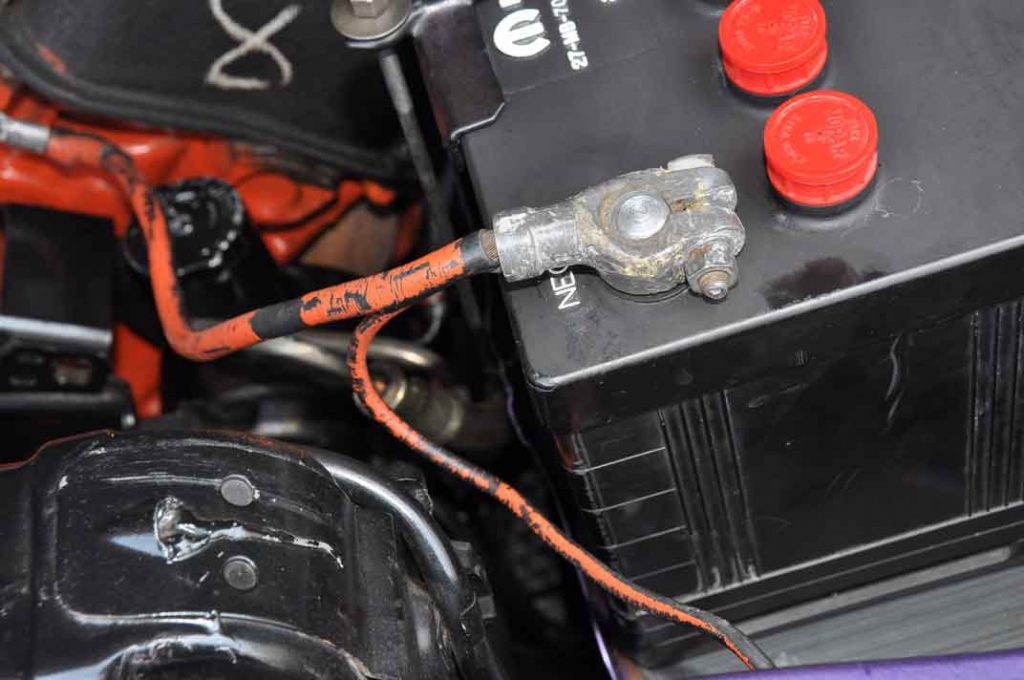
According to Steve, an original battery negative cable is the number one most difficult to find parting a ā70-ā71 Hemi restoration. Heās found only three in his lifetime (and he started at the age of three).One of the originals he found was a truck negative cableāexact except the cable that attached to the cylinder head was three feet long. Simply shortening the cable made it Platinum-grade perfect.Ā Unfortunately, the part number tag fell off so Steve doesnāt know the part number, and he canāt find another one.Ā
āCourse the first thing we wanted to do after photographing Steveās car was to bounce up and down in the rear seat, rip off the factory plastic wrap from the seatbelt buckles, try out the windshield washer and wipers, and toss an old oily, greasy tranny bellhousing in the trunk to take to the dump over a rutted, potholed, muddy road. But we ran out of time. Maybe on the next go-round.
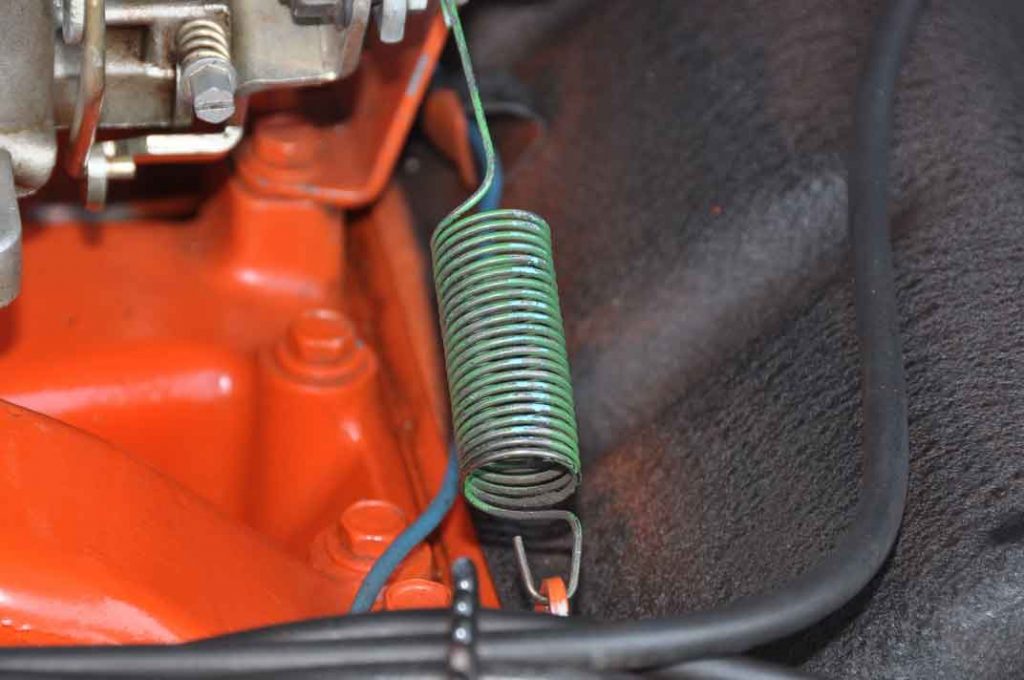
The throttle return spring still shows traces of its color stripe. Frank Badalson makes an exact repro with the correct number of coils and proper stripe.
The non-dealer-prepped Charger shows the trunk with the factory paper packing behind the spare tire and the āvehicle travelerā sheet still taped to the left of the spare.Ā According to Frank Badalson, the “B” over the G 60 (tire size) on the inside of the trunk lid is, in his opinion, a peculiarity to the Lynch Rd assembly plant.Ā Heās inspectedĀ a good number of original cars from Lynch, and they all seem to be consistent with this marking on the lid. His guess is the āBā signifies B-body, as only a ā71 B-body could have G 60 tires. All factory markings and jack instruction decal are original and pristine. Trunk mat bears date of April 14, 1971. The factory dated all this stuff just to give future collectors something to make a fuss over.
The factory used wheel opening molding screws to hold the fender tags in place, and they ignored the pre-drilled holes in the fender. Also, you can see that one tag was on top of the other tag when it hung in the interior up near the mirror when the cars came down the paint line. Hereās an example of the paper clip that the tags hung from on the B-bodies. This one was found under the carpeting on Steveās 1970 Rapid Transit System Road Runner.
The Gates hoses are dated. If you donāt have these hoses on your car from day one, you canāt find them because they were never serviced. The Corbin clamp that holds the booster hose to the check valve has a reddish color. Behind that the part no. tag is still is visible on the wiring. On non-Hemi cars the PCV valve and grommet were already on the valve covers before the engine was painted so they have paint on them, Not so with the Hemis. The early ā71 Hemis still had the ā70 3-rib PCV valve, but by April all production line Hemis were fitted with the barrel type shown here. Original heater hose isnāt even reproduced with that font and the stripe between the numbers. Note original KV hose going to the breather cap. The ā71 breather cap has three ports (note the original KV hose) unlike a ā70 which has one–unless the ā70 was a CA car which had 3 ports, because ā70 CA cars are national ā71 cars.
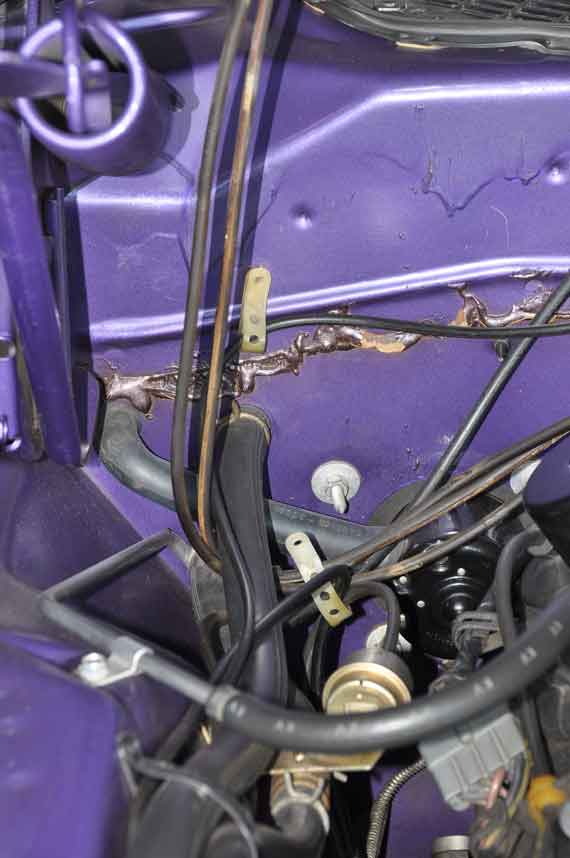
The factory used fender mounted cable ties also as wire ties as seen below the heater hose. Just think of all the effort required to exactly repro the sloppy seam sealer on the firewall as compared to the factory application.
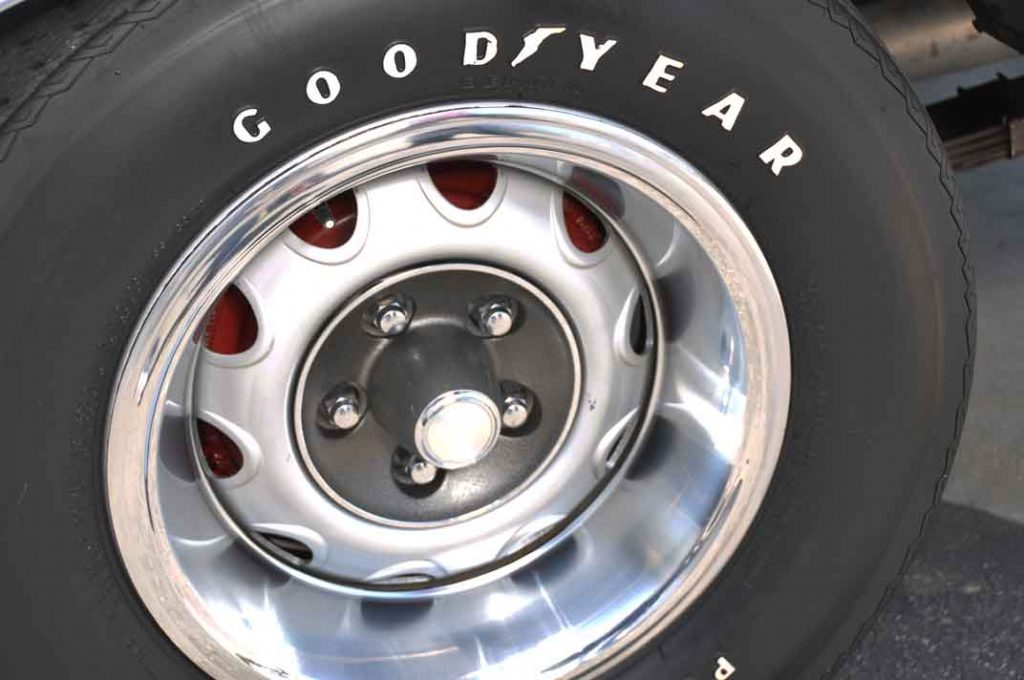
Red paint on brake drum is evident on this rallye wheel. Original tire valve extension has a white center. Repop trim rings are shorter than the originals shown here.
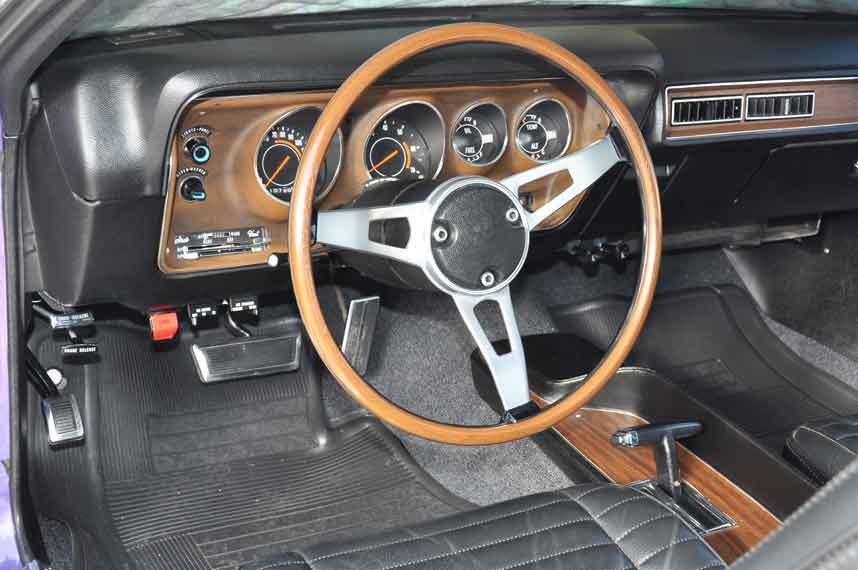
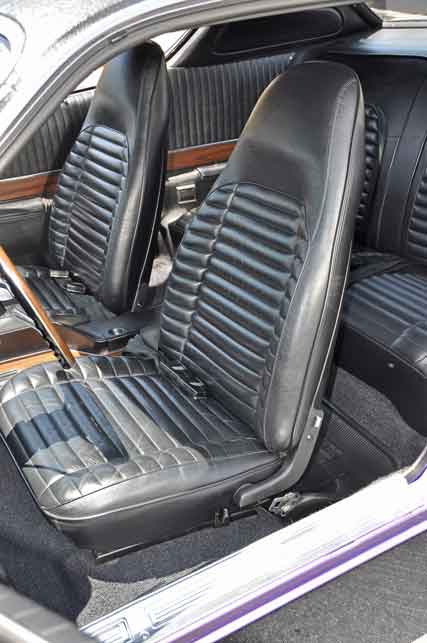
Virgin interior shows bucket seat and console options. Highlights of the extras on this highly optioned Charger include: Light Group, Performance Axle Package, power front discs, T-Flite, variable speed wipers, AM radio, rim-blow wheel, rallye dash and tach. The car stickered in at $5430.35. Current mileage is 10,760. Barely broken in.
Ā
Ā
Ā
(Photos: Steve Juliano)
Frank Badalson stepped up to the plate once again to decode the markings on the rear end. On the bottom rib of the 3rd member/carrier, the 3 white dabs signify 3.55. The orange dab signifies Sure-Grip. The yellow “423M” signifies build date of the carrier–April 23. āMā is an inspector or maybe the build person. The orange “426” near the center of the left tube is the assembly date of the rear–April 26. Over on the left side of the tube, the yellow “G046” signifies “G” series (1971), the ā046ā is the internal engineering number for the entire assemblyāā71, B-body, 3.55 SG with 11-inch rear drums. On the rear of the housing center, the “BG” signifies B-body, and of course once again āGā means G series. The other markings he believes are various inspectors. The “22” Frank believes is an inspector. Many times there is a letter in that spot. The orange dab signifies the fluid has been checked.
What The Experts Say
Roger Gibson, one of the top Mopar restorers in the hobby has stated that Steveās Hemi Charger is the best example of an original unrestored Hemicar car that he has ever seen. He notes the original paint, perfect interior, virgin engine compartment with original belts, hoses and wires, and the extremely well-preserved undercarriage.
Frank Badalson, a respected Mopar restoration authority and producer of top-quality reproduction parts states: āI saw this car at a show in Maryland in ’86 and took a few rolls of film there. But it was not until ’94 that I had a chance to go over the car thoroughly. I have about 400 photos of this car and a good quantity of notes. This is an exceptional original car and very exceptionally preserved. The undercarriage, suspension and rear end are incredible for the detail. There is virtually no deterioration. I recall the original owner telling me that he always kept the car in a garage that was under his house. The garage was always heated and cooledāno moisture! The second owner had the same set up–stored in a completely neutral environment. Once again, no moisture! I am quite certain (and we know some big collections and collectors of ā71 B-bodies) there is not another car as good and as original as this one. There certainly are some other low-mile nice ā71 Hemi B-bodies out there, no question. But overall, thereās nothing on the order of the quality of this car. It is truly incredible in the way it has been preserved. If you put this car on a lift and just spend some time taking in what it has to offer underneath, then check the trunk and the original, dated trunk mat, spare, jack, then the interior, then the engine compartment, then the original tires, wheels and lug nuts, then the paperwork, thereās nothing that compares. Now if only I could find an AAR or TA in this condition!ā
Galen Govier, noted Mopar authority and gumbers nuru states: āIāve seen a lot of cars over the years, but when you take everything in consideration–even non-Hemi cars–itās got to be the most original unmolested untouched (no nicks no scratchesālike brand new) car. Of all the cars Iāve seen, including some little old lady cars that come close, thereās nothing thatās comparable to Steveās Charger.ā
TheBruntBros, dubious Mopar photographers (non-English-speaking): āpotrzebujemy używaÄ ÅazienkÄ.ā
Sometime after these photos were taken, an event occurred that put this whole thing into perspective. Steve and a group of very, very serious Mopar originality nuts went over this Charger, and they spent hours drooling over its originality. They all wore white microfiber gloves and sweats with no metal anywhere, no phones, no pens, nothing. It was like they were at an orgy trying not to scratch anything. When they finished their inspection and oohhing and ahhing, Steveās beagle walked into the garage, pissed on the tireāand left.


